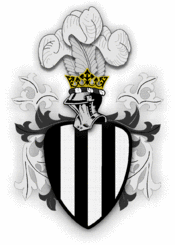Nabram coat of arms
| Nabram | |
|---|---|
 Battle cry: Nabram! | |
| Details | |
| Alternative names | Abram, Nabra, Kłobuk, Stańcowie, Waldorff, Wendorf |
| Earliest mention | 1292 - 1386 |
| Towns | Jedlinsk, Jedlnia Koscielna, Sieroszewice, Tluczan, Kossowa |
| Families | Bor, Boremski, Brodelski, Borodelski, Chotecki, Czasławski, Honckiewicz, Hondorf, Huppe, Jedleński, Jedliński, Kałczyński, Kazimirski, Kubiczek, Kubiczek de Waldorf, Mietrowski, Nadratowski, Nadrodorf, Nadrowski, Nagórka, Pejszowski, Pielgrzym, Piels, Pielstowski, Porębski, Preiss (Prajs), Prejszkowski, Rogalowski, Rogowski, Rosperski, Rospierski, Sieroszewski, Sosnowski, Underowicz, Undorf, Waldorf, Wendorf, Wolwanowski, Wolicki, Wulwanowski, Żołecki. |
Nabram is a Polish coat of arms. It was used by a number of szlachta (noble) families in 1292-1386 under Poland's Piast Dynasty. The Nabram coat of arms is also known as Abram, Nabra, Kłobuk, Stańcowie, Waldorff, and Wendorf.
Blazon
The official heraldic description of the Nabram coat of arms is, "Nabram vel Waldorff, cuius insignia in campo albo tres barre nigre, a capite clipei in longum producte." (Translation: Nabram or Waldorff, which character in white area are three black beams, from the head of shield direct on length.)[1]
The Nabram coat of arms has three vertical black stripes and three vertical white stripes, starting with white on the left side and alternating across. Three ostrich quills extend from the crowned helmet.[2][3]
References
- ↑ Jan Dlugosz, Insignia ..., nr 76, pg. 59
- ↑ Kasper Niesiecki, Herbarz, vol. VI, pg. 506-507
- ↑ Jozef Szymanski, Herbarz, pg. 192
External links
This article is issued from Wikipedia - version of the 7/19/2013. The text is available under the Creative Commons Attribution/Share Alike but additional terms may apply for the media files.
